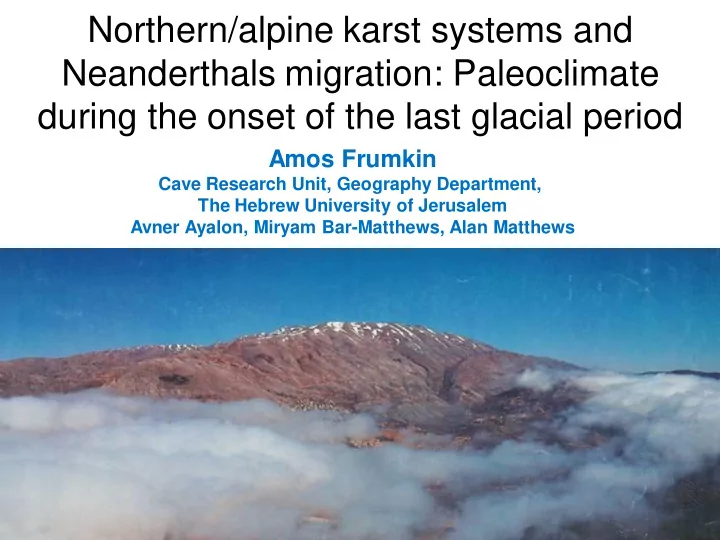

Northern/alpine karst systems and Neanderthals migration: Paleoclimate during the onset of the last glacial period Amos Frumkin Cave Research Unit, Geography Department, The Hebrew University of Jerusalem Avner Ayalon, Miryam Bar-Matthews, Alan Matthews
The bulk of skeletal remains that exhibit Neanderthal features are endemic to Europe and date from ca 300 ka to 28 ka, encompassing several climatic cycles (Zachos et el, 2001; Millard, 2008)
They are considered to be anatomically adapted to cold conditions, but they also penetrated the warm Levant, where they occupied caves in Syria and northern Israel. Israel is the southernmost occurrence of skeletal remains of these hominins. Neanderthal remains
Typical caves with Neanderthal remains in Israel: 10-30 m large, semi-open chambers in a cliff face, at low altitudes. Tabun Amud
Why did this northern hominid migrate to the warm Levant? Amud Cave plan Adult scull Infant skeleton Neanderthals remains from Amud Cave, Israel. After: Hovers; Suzuki and Takai
Most Neanderthal remains in the Levant are dated (by TL /ESR) to 70-55 ka (MIS 4 and early MIS 3) Example of Amud Cave excavations and dates (A. Hovers) 55 kyr 68 kyr
Africa Sahara Levant Taurus- Europe HOMININS Zagros Several other types of cool warm wet arid hominids cool warm cold passed and cold wet arid wet wet N settled the warm N Levant, which cool dry wet serves as a cool warm Hs wet moist bridge warm between N Hs moist continents. warm warm arid wet Neanderthals (N) Hs Migrated from N Europe to the Levant only once, during the transition Summary of from late MIS prehistoric data 5 to early MIS from the Levant 4. (Frumkin et al., 2011)
Research questions: • Is Neanderthal migration related to climate? • If so, what climate conditions promoted their southward migration? • What conditions did they encounter when they crossed on- route mountain chains?
Ice Age Europe was associated with southward migration of bio-climatic belts www.geocities.com/reginheim/europeiceage.gif Thick ice sheets in north Frozen tundra in centre Conifer forests in south We explore the southernmost limit of cold conditions (e.g. year-round snow cover) in the Levant during the last glacial period
Hall 2005 We use the southernmost high ridge in the Levant: Mt. Hermon, 2814 m asl
Geology: Uplifted, faulted, and folded Jurassic limestone Mt. Hermon
Present conditions Mt. Hermon in winter: few m of snow
Short spring, snow melts rapidly
Dry long summer, no snow remains Extensive doline-karst system
spring winter summer Winter snow accumulation in a Mt. Hermon doline may exceed 10 m due to wind, supporting short spring blooming
Studied cave location in Mt. Hermon
Surface profile topography: tectonic Mizpe Shelagim Cave ridges with Mizpe doline fields Shelagim Cave MS samples plan
Mizpe Shelagim Cave
No ice damage or permafrost morphology is observed in the cave or on the surface.
U/Th dates of Mizpe Shelagim MIS: 1 2 3 4 5 2 - speleothems show that most deposition occurred during 3 - warm periods: interglacials 4 - and short interstadials 5 - 6 - 7 - 2 - 10 20 30 40 50 60 70 80 4 - 6 - 8 - Interglacial 10 - Holocene Glacial period: intermittent, short phases of deposition 12 - 14 - 10 20 30 40 50 60 70 80 Age ka
1 2 3 MIS 5 4 Comparison between -2 isotopic records of -3 MS (high mountain, -4 black) and Soreq (low -5 hills, gray) : -6 MS carbon is heavier, -7 -2 10 20 30 40 50 60 70 80 associated with less Age (ka) -4 vegetation. -6 Why did speleothem -8 deposition stop during -10 most of the last glacial -12 period? -14 10 20 30 40 50 60 70 80 Age (ka)
MS Cave d 18 O -2 560 supperimpossed on 65 o N Neanderthal 540 migration -3 insolation (after Berger 520 and Loutre, 1991) -4 500 480 -5 460 -6 Calculated 440 paleotemperatures -7 420 of MS Cave, based on 15 fluid inclusions Cooling 10 event Lower summer T could 5 allow snow to remain on 0 the ground year-round, eliminating plants and CO 2 -5 10 20 30 40 50 60 70 80 Age (kyr )
Is Neanderthal migration associated with the southward movement of climatic and ecologic belts during the onset of the last glacial period?
Lake levels, speleothems and pollen indicate higher precipitation/ evaporation ratio during the last glacial period compared with the Holocene, so the karst system was not dry during the glacial Glacial period: high P-E period Holocene: low P-E
Conclusions Neanderthals were adapted to cold conditions and endemic to The Neandertal Europe; They penetrated into the Levant only once, during MIS 5/4 World cooling event. Their southernmost limit was in Israel, where their skeletal remains were found in Amud, Kebara and Tabun caves The MIS 5/4 cooling event is reflected by several independent proxies in Mt. Hermon MS Cave, suggesting continuous cover of snow ~2200 m asl, without significant ice accumulation. Neanderthals southward migration could be promoted by the MIS 5/4 cooing event
Thank you!
Recommend
More recommend